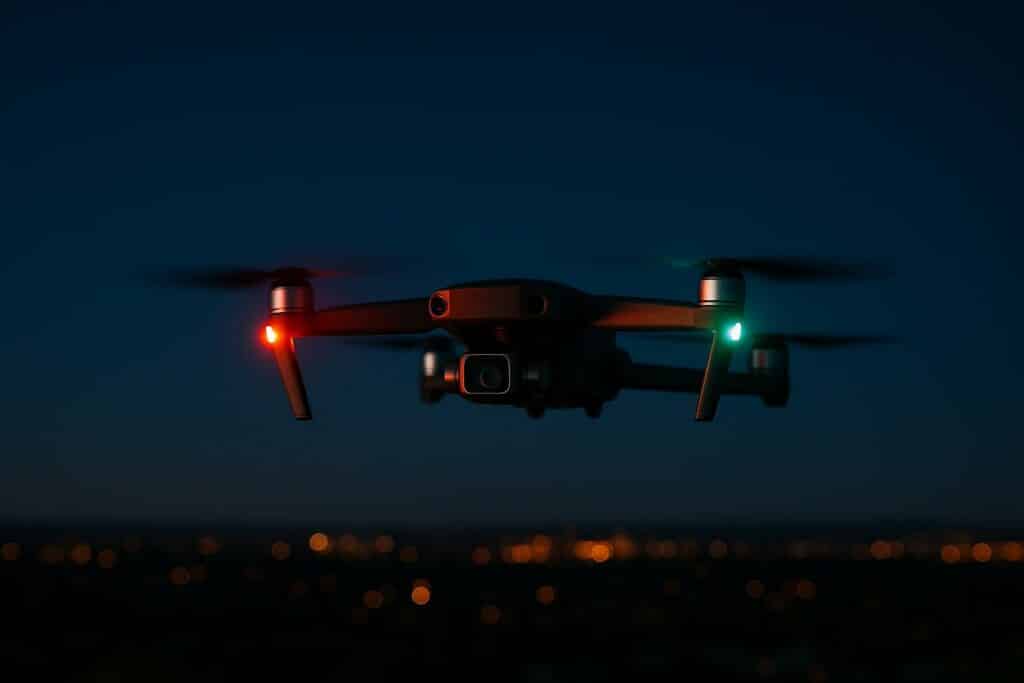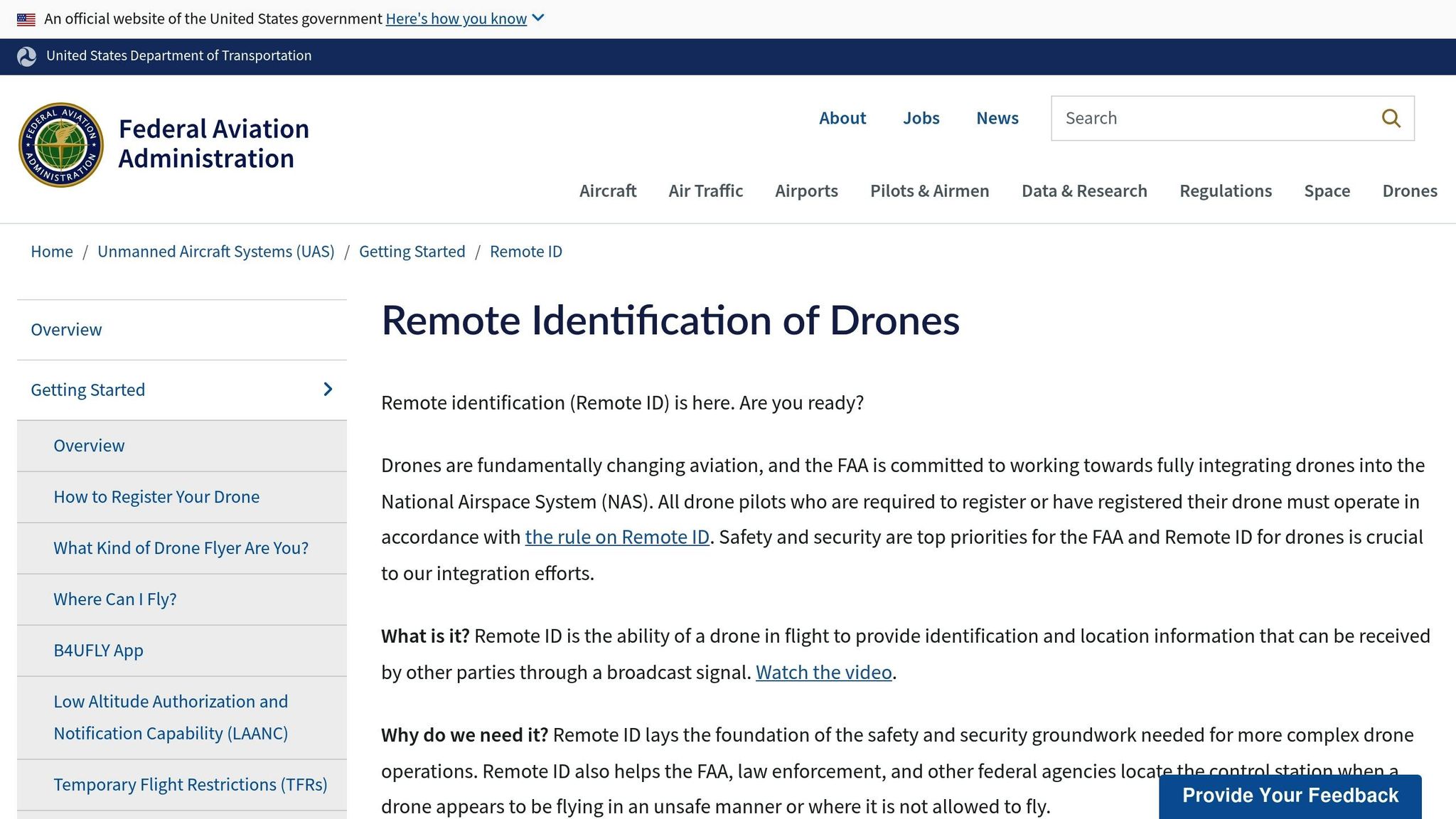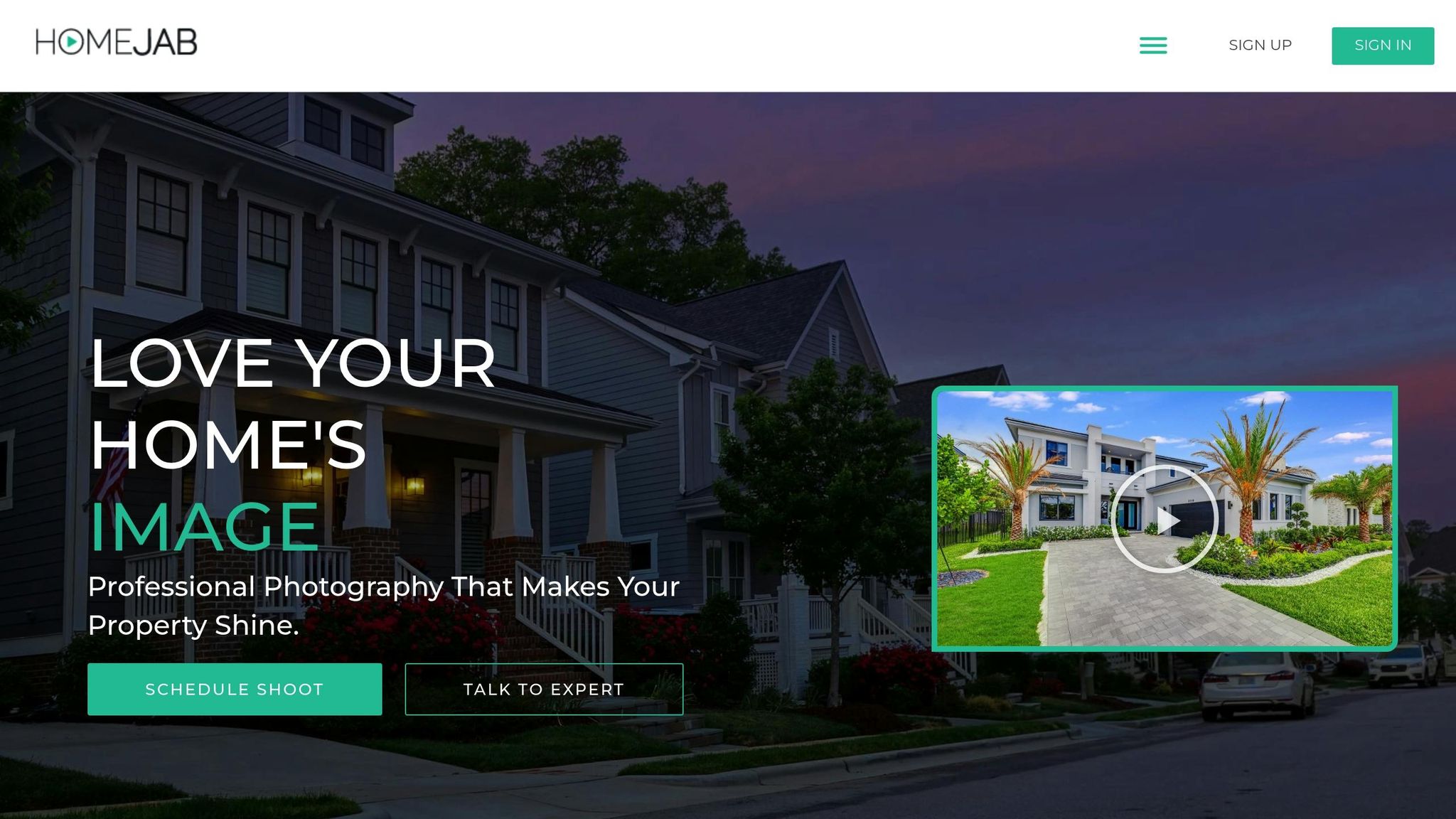Flying a drone at night? Here’s what you need to know to stay compliant with FAA rules:
- Anti-Collision Lights: Your drone must have flashing lights visible from at least 3 statute miles. These lights should flash 40–100 times per minute.
- Night Defined: Nighttime is 30 minutes after sunset to 30 minutes before sunrise.
- Light Placement: Lights must provide 360-degree visibility. Mount them strategically to avoid blind spots.
- Pilot Certification: Ensure you have completed FAA night-flight training as part of your Part 107 certification.
- Airspace Authorization: Use the FAA’s LAANC system for controlled airspace approval. Check for restrictions or advisories.
Proper lighting ensures safety for other aircraft and compliance with FAA standards. For real estate professionals, it also helps create stunning twilight shots while avoiding penalties. Always test your lights, document compliance, and keep backups ready.
Keep reading for detailed guidelines on equipment, mistakes to avoid, and tips for safe operations.
Flying your Drone at Night Legally – Lume Cube Lighting
FAA Night Flight Lighting Standards
The FAA has laid out specific lighting rules under Part 107 that drone operators must follow when flying at night. These standards are designed to ensure safety in the skies, particularly focusing on anti-collision lighting systems that make drones visible to other aircraft in low-light conditions.
Required Anti-Collision Lighting
Under FAA Part 107, drones flying at night must have anti-collision lights that meet strict requirements. These lights need to be visible from at least three statute miles in clear conditions, giving manned aircraft enough time to detect and avoid your drone. This visibility standard is a critical part of maintaining safe operations.
The lights must flash or strobe between 40 and 100 times per minute – steady lights do not meet FAA regulations. While both white and red lights are acceptable, white is often chosen for its superior visibility against dark backgrounds. It’s also essential that the lights are bright enough to cut through urban haze or rural darkness; decorative LED strips or weak lighting won’t meet the necessary intensity.
"The purpose of anti-collision lighting is not for the remote pilot to maintain visual line of sight and see the orientation of their small unmanned aircraft, but for the awareness of other pilots operating in the same airspace." – FAA
Anti-Collision vs. Navigation Lights
It’s important to understand the distinction between anti-collision and navigation lights. Anti-collision lights are the flashing or strobing lights required by the FAA for night flights, designed to alert other aircraft. Navigation lights, on the other hand, are steady red, green, and white lights that indicate an aircraft’s position and orientation. While navigation lights are common on manned aircraft, they are not required for drones under Part 107. For compliance, only flashing anti-collision lights are necessary.
360-Degree Visibility and Mounting
Proper placement of anti-collision lights is just as important as their technical specifications. These lights must provide full 360-degree visibility, ensuring that your drone can be spotted from any angle. Mounting the lights on top of the drone is often the best option since pilots typically scan downward when looking for obstacles.
If your drone has a complex design, you might need multiple lights or an omnidirectional lighting system to achieve full coverage. To stay compliant, document the visibility range and flash rate of your lighting system, and keep any technical specifications or receipts as part of your flight records. This documentation can be crucial if your compliance is ever questioned.
Night Flight Legal Compliance Checklist
To ensure your night flight operations meet FAA standards for lighting and safety, follow this pre-flight checklist carefully.
Check Lighting Compliance
Start by testing your anti-collision lights to ensure they meet FAA visibility and flash rate standards. Activate the lights and inspect them from multiple angles to confirm they are visible as required. Record key details about your lighting system – such as the manufacturer, model, and technical specifications – in your flight log. If you’re using aftermarket lights, make sure they are specifically designed for aviation purposes. Additionally, check the battery level of your lighting system separately from your drone’s main power supply, and always have backup power on hand.
Pilot Certification and Training
Make sure your remote pilot certificate includes the required night-flight training. Double-check that your insurance policy covers night operations, and review sectional charts to identify any low-light obstacles in the area. Keep your certificate easily accessible in case it’s requested by law enforcement or FAA inspectors. To further prepare, practice using features like the return-to-home function in a controlled environment. This can help you navigate more confidently during night operations when visual cues are harder to detect.
Once your certifications and training are squared away, move on to verifying airspace and system compliance.
Airspace Authorization and Remote ID
If you’ll be flying in controlled airspace, secure the necessary authorization through the FAA’s LAANC system. Be sure to check for any night-specific restrictions or limitations in the area. Before takeoff, confirm that your Remote ID is broadcasting correctly by using FAA-approved tools. It’s also essential to review any current Notices to Airmen (NOTAMs) for your flight location, as these may include temporary flight restrictions or other advisories. If you’re operating near airports or in complex airspace, consider setting up a communication plan with local air traffic control to stay informed about any changes or potential conflicts during your flight.
Anti-Collision Light Selection Guide
Choosing the right anti-collision lights is essential for ensuring safety and achieving high-quality aerial imagery, particularly in real estate photography. It’s crucial to select lights that meet FAA standards while delivering reliable performance.
Key Features to Consider
When assessing anti-collision lights, focus on these critical factors to ensure compliance and functionality:
- Flash Rate: FAA regulations require a strobe rate of 40 to 100 flashes per minute. Solid lights do not meet compliance standards.
- Visibility Range: The light must be visible from a minimum of 3 statute miles, as outlined earlier.
- Color Options: Compliant colors include white and red, with white offering better visibility against darker backgrounds. Always verify that the light uses only approved colors.
- Mounting Options: Look for lights with versatile mounting systems, such as 3M tape, straps, or zip ties, to achieve full 360° coverage. If a single light doesn’t provide omnidirectional visibility, consider using multiple units placed 120 degrees apart.
- Power Management: Options range from disposable batteries to rechargeable systems or direct drone power connections. Ensure the power source aligns with your flight duration needs.
- Weather Resistance: A must-have for operations in unpredictable weather. Some models include water-resistant designs to handle light moisture or sudden weather changes.
Below is a comparison table highlighting how popular anti-collision light models match up to these criteria.
Anti-Collision Light Comparison
| Light Model | Visibility Range | Flash Rate | Power Source | Weather Protection | Weight | Key Advantages | Notable Limitations |
|---|---|---|---|---|---|---|---|
| LumeCube Strobe | 3+ miles | 40–100 bpm | Rechargeable | Standard | Lightweight | FAA-trusted brand, proven compliance | Limited weather sealing |
| Firehouse ARC V | 3+ miles | 40–100 bpm | Rechargeable | Standard | Lightweight | Widely accepted, easy mounting | May lack waterproofing |
| ACR Firefly Pro SOLAS | 3+ miles | Variable modes | AA Lithium | Waterproof | 2.39 oz | Long 56-hour battery life, all-weather use | Heavier; not tailored for drones |
| Aveo Engineering PicoMax | 3+ miles | Compliant range | DC rechargeable | Water resistant | Moderate | Bright output, flexible mounting | Activation button may drain battery |
| Survival Systems DS-30 | 3+ miles | Compliant range | 9V or 11V | Standard | Moderate | Affordable, hardwiring option | Dims with 9V battery; better with 11V |
The ACR Firefly Pro SOLAS is a standout choice for operators prioritizing reliability. Its robust 56-hour battery life on AA lithium batteries makes it ideal for extended missions or emergencies. However, its 2.39-ounce weight may be a drawback for drone-specific operations.
For day-to-day use, the Aveo Engineering PicoMax delivers impressive brightness and water resistance, thanks to its USB cover design. Its adaptable mounting system suits various drone setups, but users should secure the activation button to avoid accidental battery drain.
For those on a tighter budget, the Survival Systems DS-30 offers an economical option. While its performance with a 9-volt battery is less powerful, upgrading to an 11-volt 3S configuration can significantly improve brightness.
Always document the compliance details of your chosen light from the manufacturer’s website. This record can prove invaluable during FAA inspections or in case any questions arise about your equipment’s adherence to regulations.
sbb-itb-82c5f45
Common Night Flight Mistakes and Prevention
Flying drones at night can be tricky, even for seasoned operators. Knowing the common mistakes and how to avoid them can save you from breaking rules, damaging equipment, or risking safety.
Frequent Compliance Failures
Several issues tend to crop up during night flights, including visibility problems, poorly placed lights, battery troubles, outdated training, and lapses in Remote ID compliance.
One common oversight is failing to ensure that anti-collision lights are visible from all angles. In urban settings, ambient light might hide weak strobes, and these shortcomings often go unnoticed until an inspection or incident reveals them. To avoid this, make sure your lights are mounted to provide full 360-degree coverage without blind spots.
Battery issues are another frequent challenge. If your lights fail mid-flight due to poor battery management, it’s more than just inconvenient – it’s a safety risk and could put you out of compliance with regulations.
Outdated training and certifications can also cause problems. Regulations and best practices change over time, and operators who don’t stay updated may unknowingly break the rules.
Then there’s Remote ID non-compliance – a mistake some pilots make by focusing solely on lighting requirements and neglecting other crucial standards. This oversight can lead to hefty penalties.
The good news? These risks can be managed with some forward planning and smart strategies.
Prevention Strategies
To keep your night flights safe and compliant, consider these practical tips:
- Test your lights thoroughly. Check them from multiple angles to ensure they’re visible all around. Using omni-directional lighting systems with redundancy can help avoid single points of failure.
- Stay on top of battery performance. Cold weather can drain batteries faster, so always carry spares and test them before your flight. Monitoring battery levels during operations is critical to prevent power loss at the worst moments.
- Keep your training up to date. Regularly review evolving regulations and sharpen your skills through refresher courses. This ensures your certifications and knowledge remain current.
- Use a pre-flight checklist. Include everything from checking your lighting setup and Remote ID compliance to reviewing airspace permissions, weather conditions, and equipment functionality. A laminated checklist in your kit can help you stay consistent.
- Document everything. Take photos of your lighting setup and keep records of equipment specs and test results. These records can be invaluable during inspections and help you spot issues early.
- Practice emergency procedures. If your lights fail mid-flight, you’ll need a plan. Familiarize yourself with backup navigation options and safe landing protocols. Practicing these scenarios regularly will prepare you to handle real emergencies with confidence.
Drone Lighting Compliance for Real Estate Photography
The world of real estate photography has reached new heights – literally – with the use of drones to capture stunning property views. But when it comes to flying drones after dark, strict FAA lighting regulations are non-negotiable. These rules aren’t just about staying on the right side of the law; they also play a key role in producing high-quality aerial images. Let’s break down why compliance matters and how it enhances nighttime photography.
Supporting Quality Aerial Imagery
Following FAA lighting regulations does more than ensure legality – it directly impacts the quality and safety of your nighttime drone shoots. FAA-compliant anti-collision lights allow you to maintain clear visual contact with your drone throughout its flight. This is essential when capturing those magical golden hour and blue hour shots that make properties pop.
Safety is another major factor. With proper lighting systems, drone pilots can confidently navigate around potential obstacles like buildings, power lines, or trees – features that can be tricky to spot in low-light conditions. This added precision makes it easier to frame the perfect exterior shots of luxury homes, sprawling estates, or commercial properties.
Weather unpredictability is also easier to manage with compliant lighting. During the brief window of ideal lighting after sunset, reliable, weather-resistant anti-collision lights help ensure your shoot stays on track, even if visibility changes unexpectedly. This reliability is critical when working under tight deadlines and accommodating busy real estate schedules.
HomeJab, a leader in real estate photography, builds on these benefits by implementing rigorous compliance protocols to consistently deliver exceptional aerial imagery.
How HomeJab Ensures Compliance
HomeJab takes drone lighting compliance seriously, combining strict regulatory adherence with a commitment to delivering top-tier images. Their professional photographers go beyond the standard FAA Part 107 certification, completing advanced training to ensure they’re fully equipped for nighttime operations.
Every HomeJab photographer is required to use FAA-approved lighting systems and provide documentation confirming compliance before taking on nighttime assignments. This includes mastering key details like proper mounting techniques, managing battery life, and conducting thorough pre-flight checks to ensure all lighting equipment is functioning properly.
To stay ahead of changing FAA rules and emerging lighting technologies, HomeJab provides ongoing training and requires photographers to recertify for nighttime operations as needed. This proactive approach ensures clients always receive compliant and high-quality service, no matter who handles the shoot.
Clear communication with clients is another cornerstone of HomeJab’s compliance strategy. Real estate professionals are kept informed about how lighting rules apply to their projects, any potential limitations, and special considerations for nighttime shoots. This transparency helps set realistic expectations and ensures smooth collaboration from start to finish.
Conclusion and Key Takeaways
FAA lighting compliance plays a pivotal role in ensuring safe and professional drone operations, especially when it comes to capturing high-quality aerial photography during night flights. These regulations aren’t just about meeting legal requirements – they’re about protecting the airspace, enhancing safety, and enabling photographers to achieve those breathtaking twilight and evening shots that elevate real estate listings.
To operate successfully at night, you need more than just a drone. FAA-compliant equipment is essential, along with proper preparation, including an up-to-date Part 107 certification, airspace authorization, and adherence to Remote ID requirements. When these elements are in place, you can operate with confidence, knowing your flights are both safe and legal.
Compliance also brings practical benefits. It ensures reliable operations by reducing delays and allowing photographers to stick to tight schedules, particularly during the golden and blue hours when lighting is perfect for real estate photography. Proper anti-collision lighting not only enhances safety but also minimizes disruptions caused by weather-related challenges, helping projects stay on track.
Proactive measures are key to avoiding compliance issues. Routine equipment checks, effective battery management, and pre-flight lighting inspections should become part of your workflow. By mastering proper mounting techniques and understanding equipment specifications, you can steer clear of common regulatory missteps and focus on delivering outstanding results.
Companies like HomeJab showcase how meeting compliance standards can translate into a competitive edge. By treating regulations as opportunities to refine operations, they consistently deliver exceptional results while maintaining safety and reliability.
Investing in compliant lighting and ongoing training isn’t just about ticking boxes – it’s about reducing risks, improving safety, and capturing superior aerial images. As drone technology evolves and FAA guidelines adapt, staying informed and prepared will ensure your operations remain profitable and ahead of the curve in the competitive real estate photography market.
FAQs
What do I need to do to make sure my drone’s anti-collision lights meet FAA rules for flying at night?
To meet FAA requirements for night flights, your drone must be equipped with flashing or strobing anti-collision lights. These lights need to be visible from at least three statute miles and flash at a rate of 40 to 100 times per minute. Always double-check that these lights are working properly and have enough battery life to last through your entire flight.
You’ll also need to use the correct position lights: red on the left side, green on the right, and white on the tail. These lights are essential for maintaining visibility and orientation during nighttime operations, as mandated by the FAA.
What steps can I take to ensure my drone’s lighting meets FAA requirements for night flights and avoid penalties?
To make sure your drone’s lighting meets FAA rules for night flights, start by documenting the setup and visibility of your anti-collision lights. These lights need to be visible from at least three statute miles. Capture clear photos or videos showing the lights in operation – this can act as proof that your drone complies with the regulations.
It’s also important to keep a pre-flight checklist that includes a step to confirm the lights are working properly before every flight. Keeping a log of these checks not only demonstrates compliance but can also protect you from fines during FAA inspections. Don’t forget regular maintenance and testing of your equipment – these steps are crucial for staying within the rules and ensuring safe flights.
What’s the difference between anti-collision lights and navigation lights, and why aren’t navigation lights required for drones under Part 107?
Under FAA regulations, drones flying at night must have anti-collision lights. These lights should be bright enough to be seen from at least 3 statute miles away and must flash in a way that helps avoid potential collisions. This requirement is a crucial safety measure to keep the drone visible in low-light environments.
Navigation lights, which are standard on manned aircraft to indicate direction and orientation (such as red for the left wing and green for the right wing), are not mandatory for drones under Part 107 rules. For drones, the emphasis is on anti-collision lights to ensure visibility and safety during nighttime operations.














